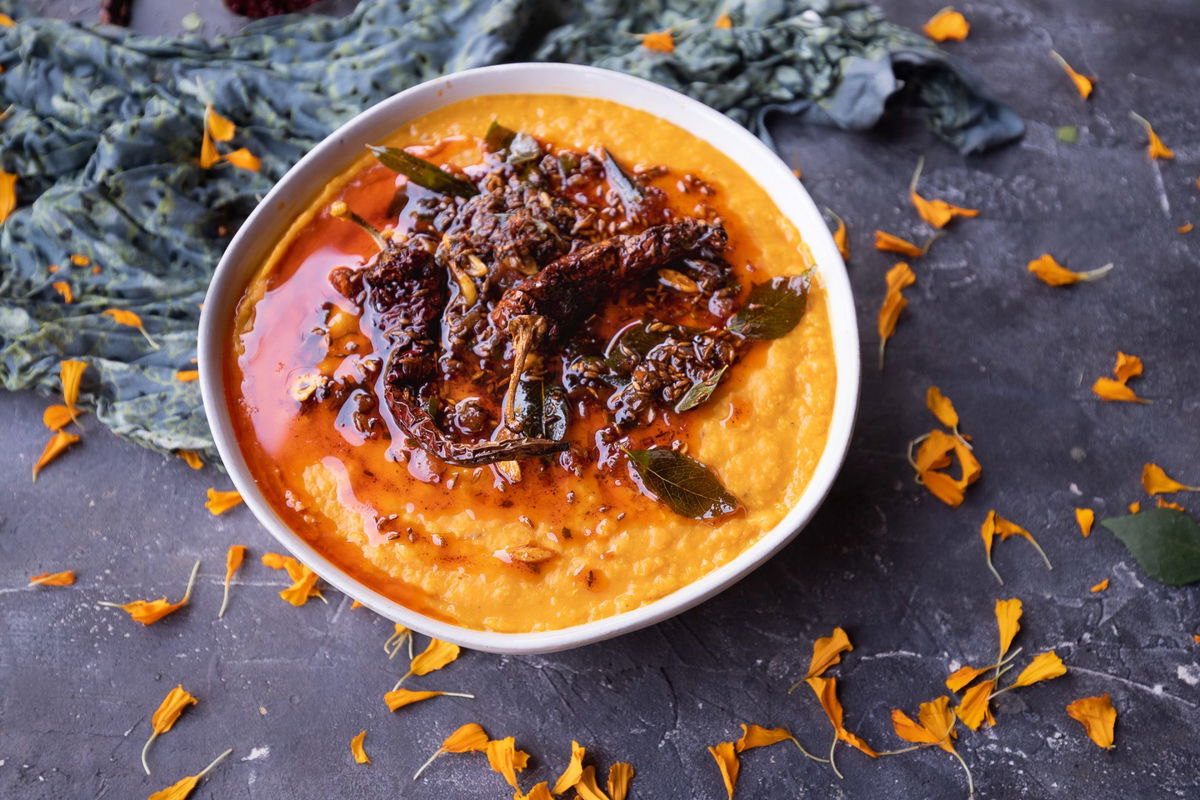Handvo is a traditional Gujarati lentil steam cake. It is savory, spicy, packed with vegetables, and topped with mustard and sesame seeds. It is usually made with dudhi (opo squash) but can be made with many different vegetables like onions, cabbage, carrots, or cauliflower. Every Gujarati family has their favored variations on handvo. This is my version of the recipe passed down to me by my mother and grandmother.
About Handvo
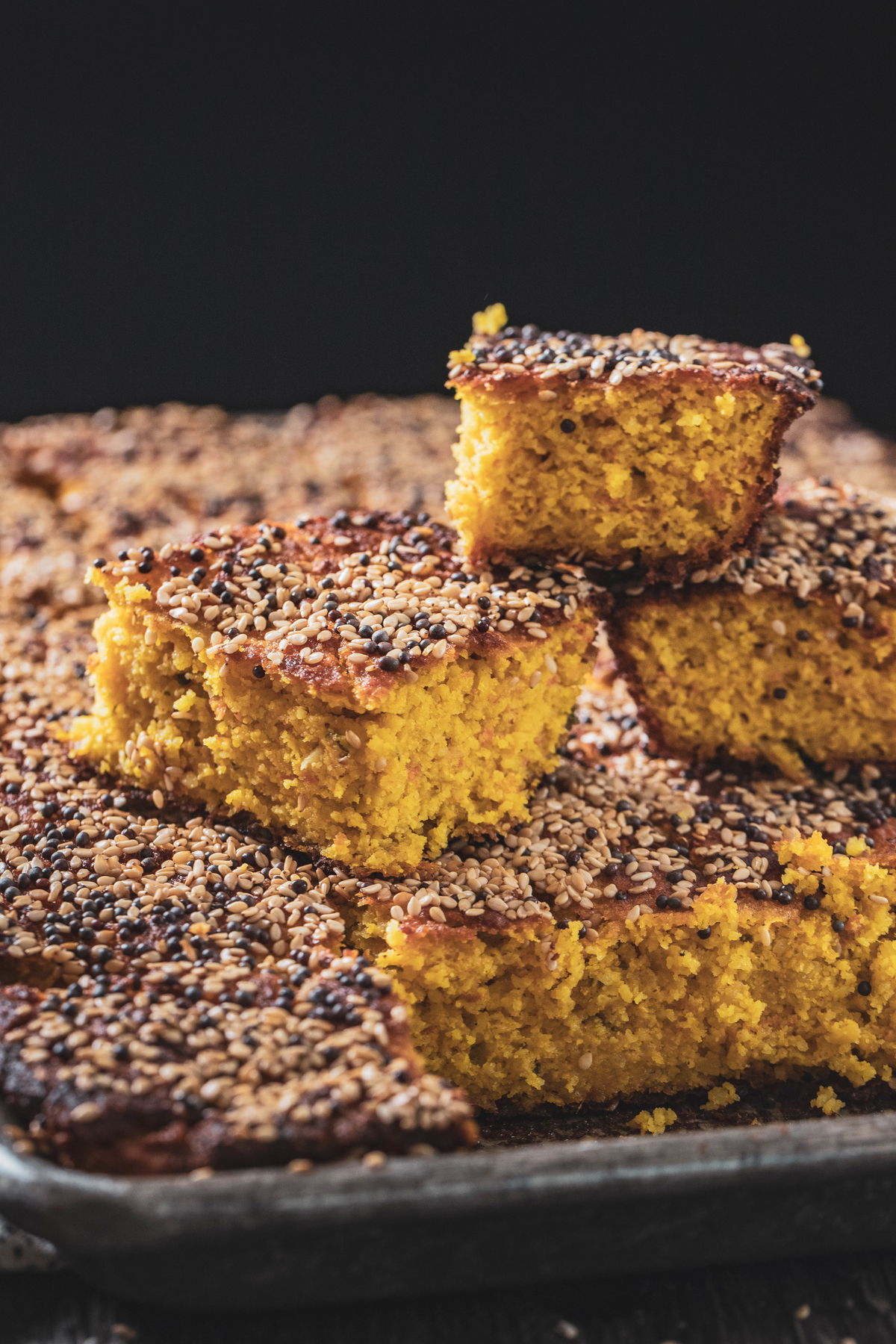
Gujarati food has a history that veered away from many other food traditions in India due to Jainism. Gujarat was one of the first states to develop a vegetarian-focused cuisine, where lentils were the primary source of protein. Pairing rice and lentils is a recurring theme in Gujarati food, possibly because apart, they form “incomplete” proteins, but together form a “complete protein.”
In addition to being a very filling, nutrient-packed dish, handvo is portable. Gujaratis are known for being travelers, as many Gujarati merchants traveled long distances for trade. For that reason, Gujarati cuisine features a lot of snacks (farsan), such as handvo, that can quickly be eaten during travel.
My grandmother used to make handvo on the chulha, a mud stove with an open fire. She cooked it in a covered pan with coals on the lid so it would crisp up on both sides. Although I adored the flavor of her flame and charcoal cooked handvo, I prefer this oven-based method, which uses a sheet, as it is less temperamental. It is much easier to cook indoors and to get consistent results with that perfect, toasty crust.
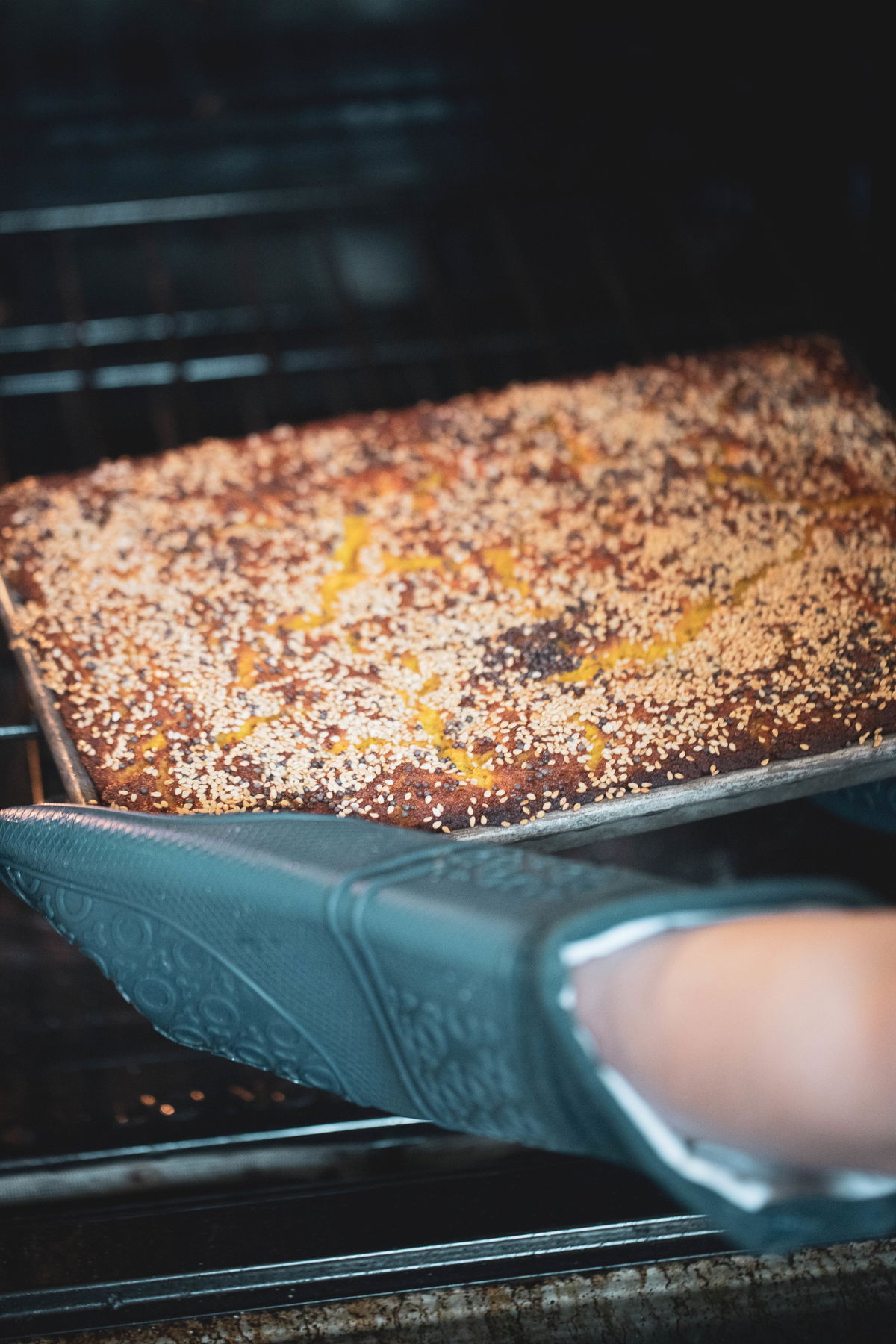
Today, handvo is often served to guests alongside cha (chai), or as part of a thali. In my family, we often ate handvo for tea in the afternoon, or it replaced a full meal, whether breakfast, lunch, or dinner. We eat handvo with some oil on the side. You take a piece of handvo, dip it in the oil, and enjoy. We used peanut oil, which was very common in India, but now my parents have switched to olive oil because it is healthier.
Ingredients

- Rice and Lentils or Handvo Flour – you can buy handvo flour from a store or make it yourself. Using handvo flour allows you to skip the overnight soaking process.
- Eno – used as a leavening agent, very common in Gujarat. You can use baking soda in its place.
- Yogurt and Lemon Juice – lemon juice because Indian dahi (yogurt) usually is sourer than Western yogurt. It especially helps when making the instant version since it skips the fermentation process that typically provides some souring.
- Vegetables: dudhi is the most traditional, usually combined with other vegetables such as carrots, greens like spinach, and methi; green onions, corn, green beans, peanuts, cauliflower, and any vegetable can be added. Some people add potatoes; I don’t like that idea. I like to pick 3-4. I like something that is squash-like, often using zucchini or any squash in place of dudhi.
- Mustard Seeds
- Sesame seeds
- Chili powder
- Ginger-Garlic paste
- Hing (optional)
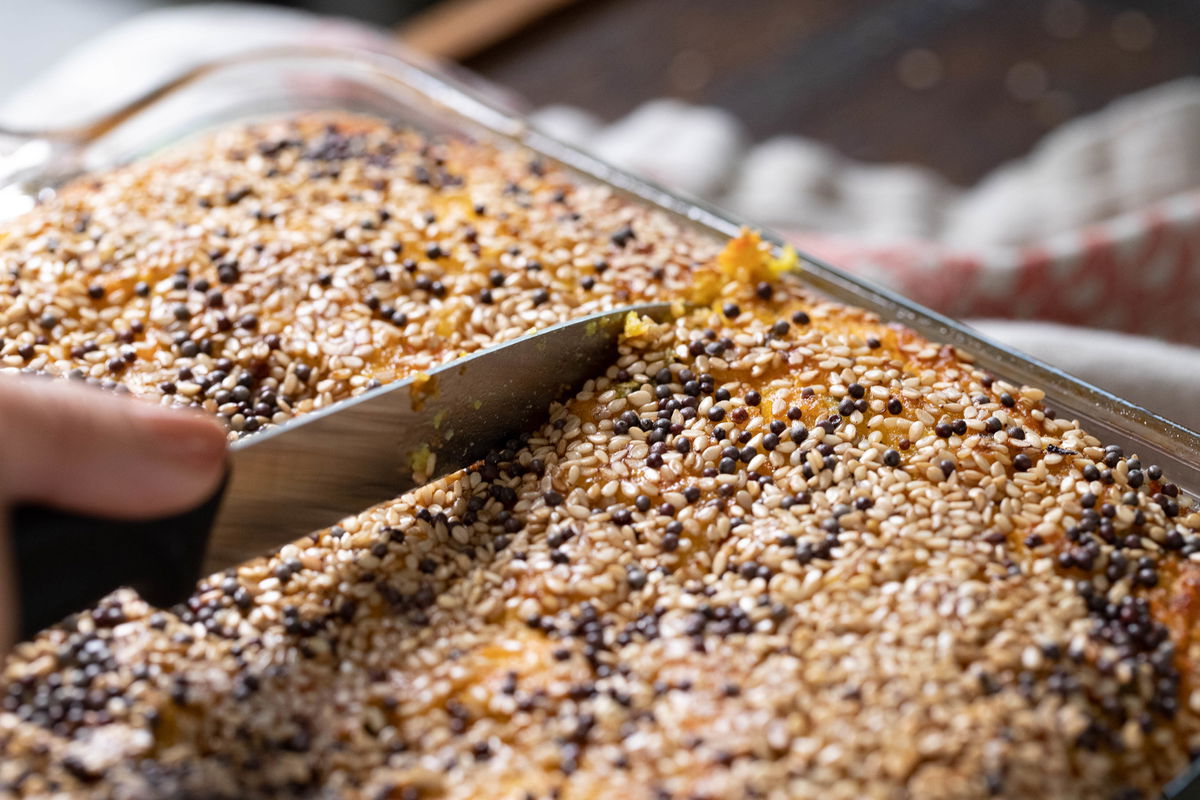
Key Steps
Mix the Dry Ingredients
In a large bowl, combine handvo flour, salt, Kashmiri chili powder, turmeric powder, and jaggery. Mix well.
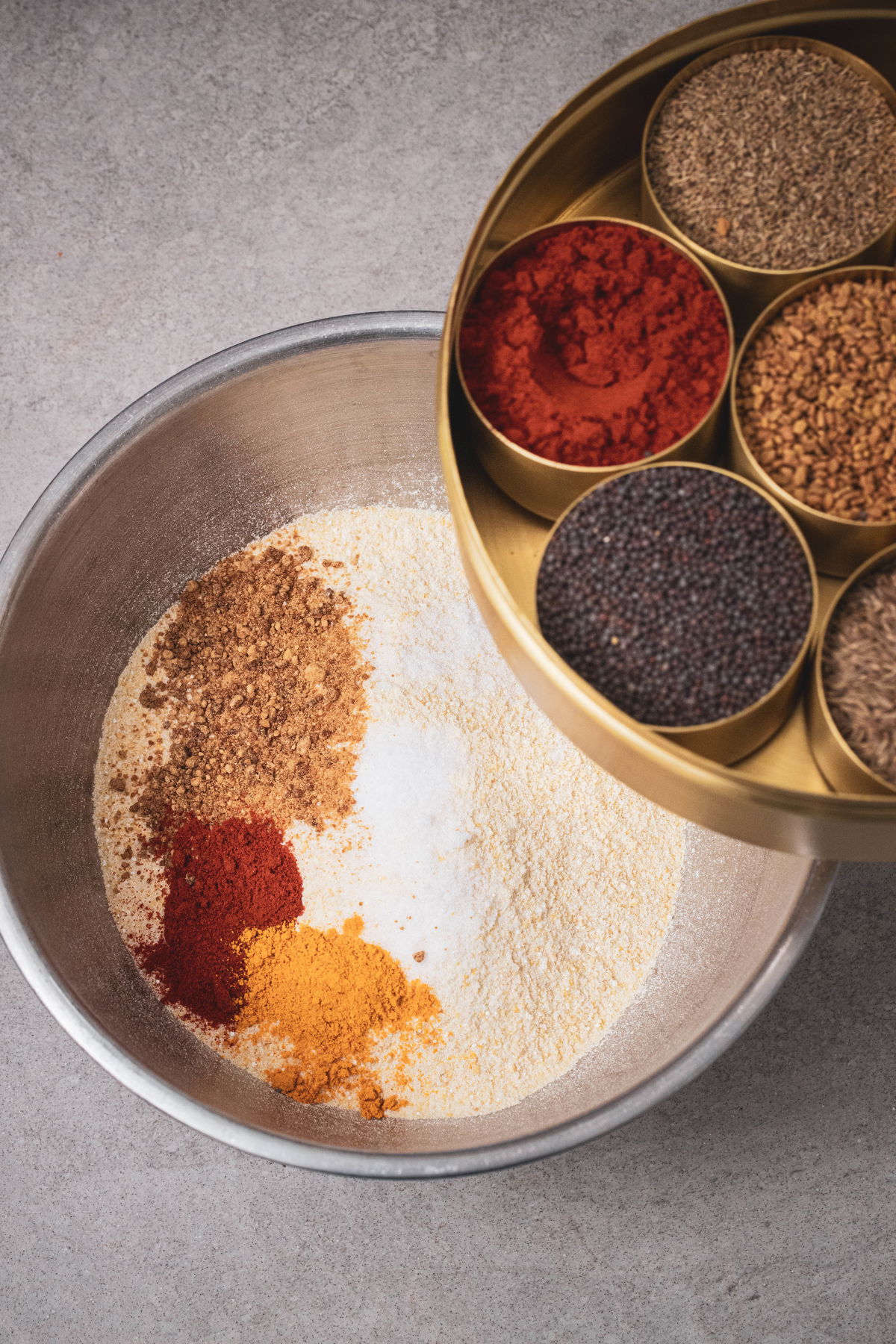
Form the Batter
Add yogurt and water gradually to the dry mix to form a batter with a cornbread consistency. Use up to 2 cups of water. Add the water slowly to avoid a runny batter. It should be thick but pourable.
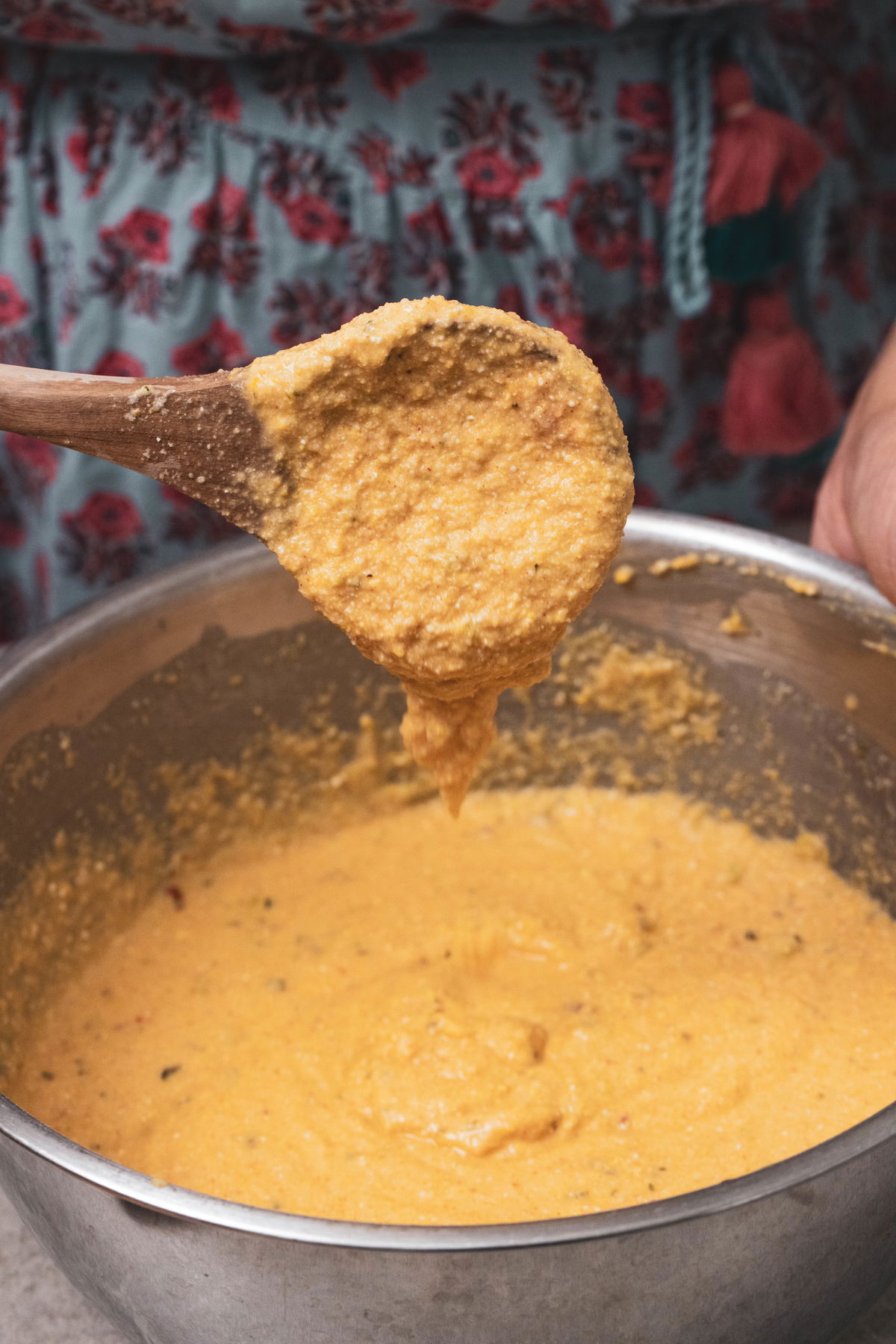
Add Vegetables and Ginger-Chili Paste
Mix in the ginger-chili paste, fenugreek leaves, and shredded vegetables of your choice. I most often use dudhi and carrots. Zucchini or similar squashes work well in place of dudhi. Spinach or other greens also make a nice addition.
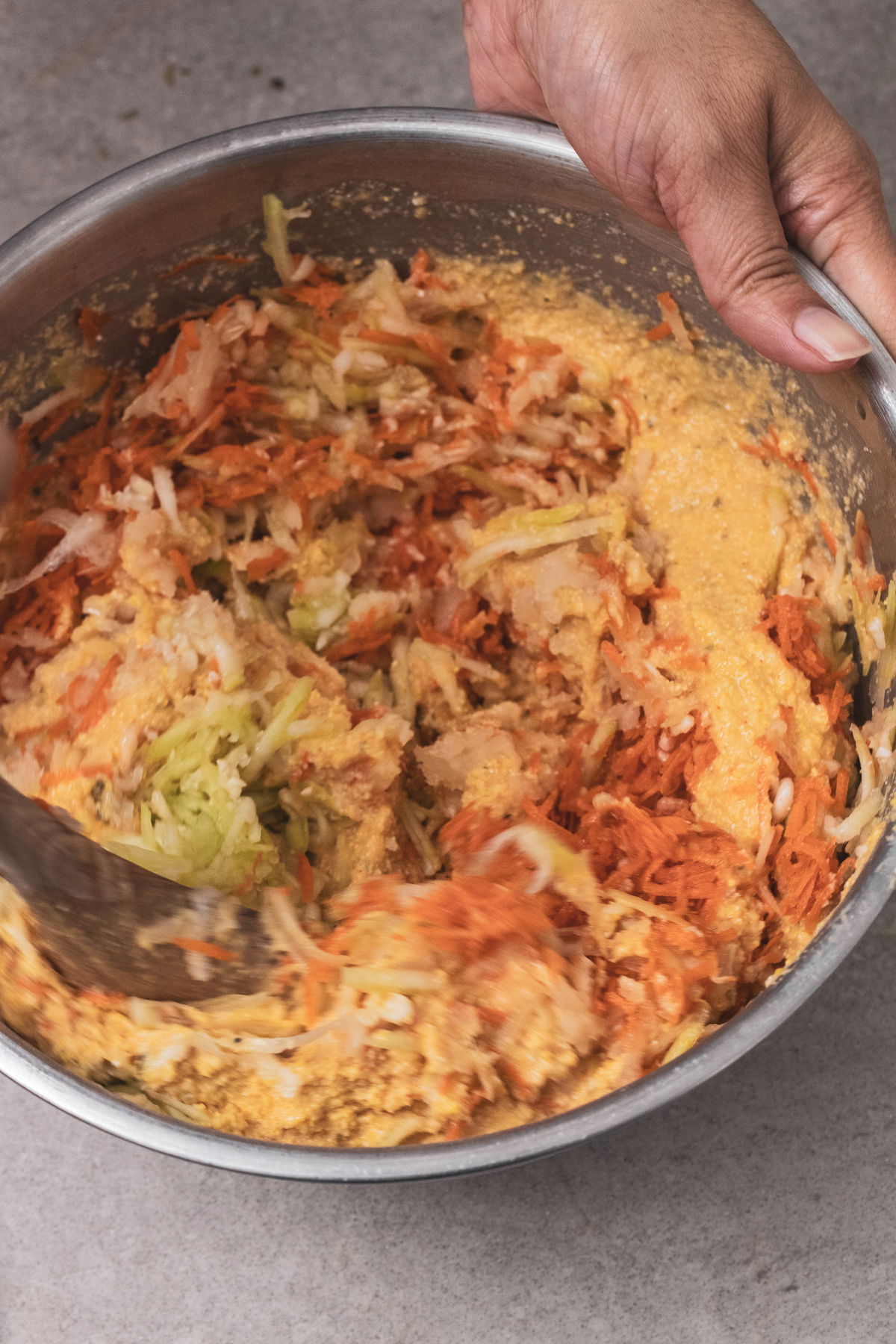
Prepare the Pan
Brush a one-quarter sheet pan or an 8×8 glass pan with oil. Sprinkle some sesame and mustard seeds across the bottom.
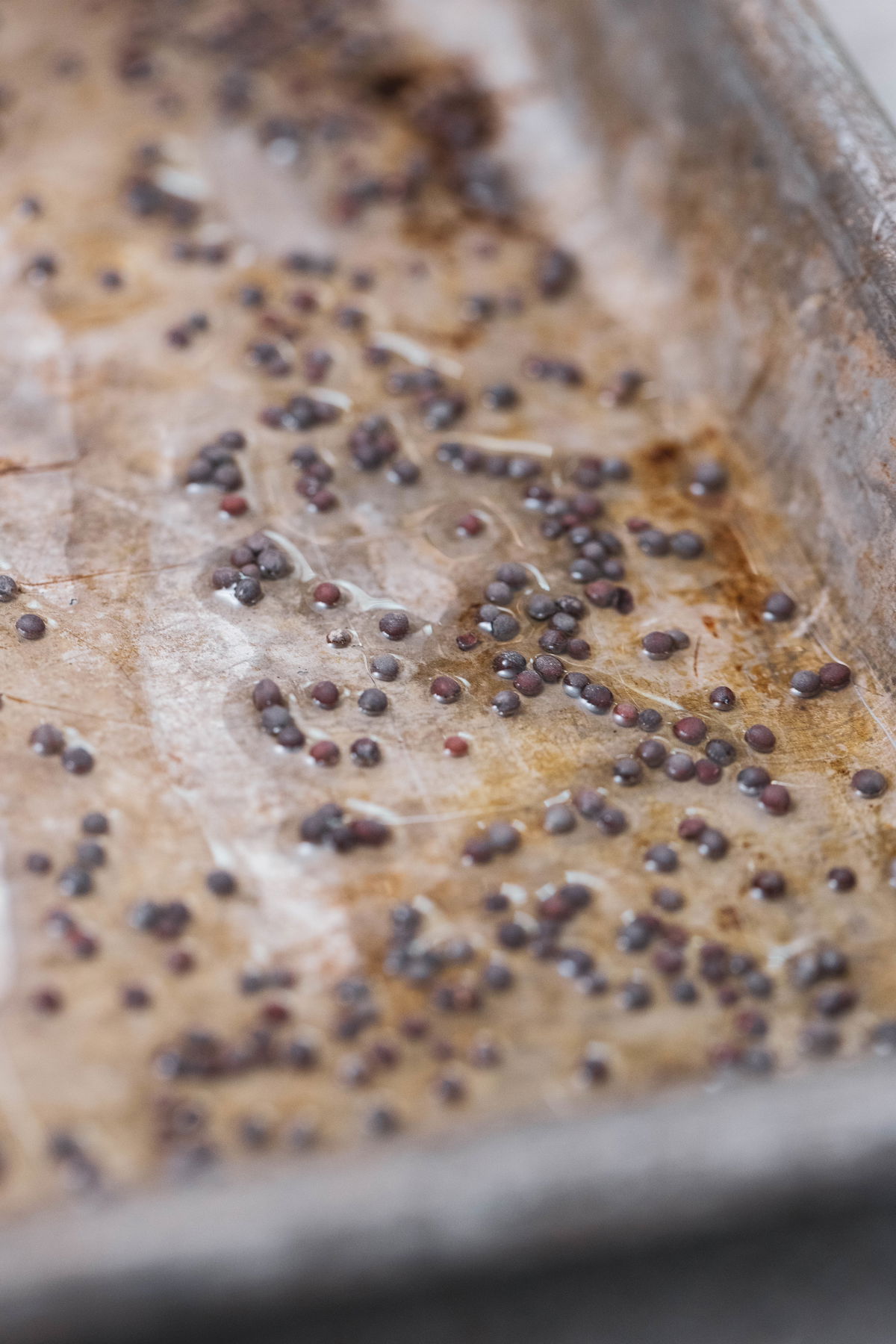
Bake the Handvo
Pour the batter into the prepared pan. Top with remaining oil and sprinkle with remaining sesame and mustard seeds. Bake at 400°F for 45-55 minutes until a knife inserted in the center comes out clean. Optionally, you can finish by broiling for a few couple of minutes to further toast the top. Watch the handvo carefully to avoid burning it.

Cooking Tips
- Make sure to use enough oil. Oil gives it moisture, helps brown the top, and keeps it from sticking to the pan.
- You can also make this in cupcake pans. It creates wonderful individual servings that each have their own crust. It’s like getting a corner piece every time. These have more of a tendency to stick, so be sure your cupcake tin is greased well.
- You don’t have to temper the seeds in hot oil separately. Some people will bake and then add a vaghar on top, then bake it some more. The way my mom taught me to make this, there is no need for it. When you add enough oil and bake it correctly, the tempering will happen during the baking process.

Variations
- Using whole rice and lentils. Handvo is traditionally made with rice and lentils that are soaked overnight and ground separately. The rice, coarsely, and lentils smooth. Then fermented overnight or up to 24 hours, depending on the weather (warmer weather accelerates fermentation).
- Handvo Flour: you can make your own or buy it from the store. See this recipe for handvo flour, which is helpful for many other dishes as well, such as muthiya and dhokla.
- With a leavening agent – I use Eno as a leavening agent. Eno is made from a mix of sodium bicarbonate (baking soda) and citric acid. When it gets wet in the batter, the acid combines with the baking soda and bubbles up. You can substitute baking soda and lemon juice or citric acid if you like.
- Without a leavening agent – traditionally, handvo relies on natural fermentation for leavening. The rice and lentils are left out overnight to ferment, which creates carbon dioxide bubbles, much like the sodium bicarbonate method but much slower.
- Use Quinoa in place of Rice – quinoa has become a popular alternative to rice in recent years since it is richer and proteins and less processed than white rice. I have tried this many times, and it is just as delicious. Simply replace the rice for quinoa. Use the same amount of quinoa as you would rice.

Storage
Handvo has to be refrigerated to be preserved; since it is made with lentils, they will start to turn and smell bad after about 24 hours if left at room temperature.
Handvo freezes very well. My aunt used to make tons of Handvo and freeze it. Wrap it in foil and put it in a plastic bag to protect it against freezer smells. It can be reheated in the microwave or oven.
Recipe
Handvo
Handvo is a traditional Gujarati lentil steam cake. It is savory, spicy, packed with vegetables, and topped with mustard and sesame seeds.
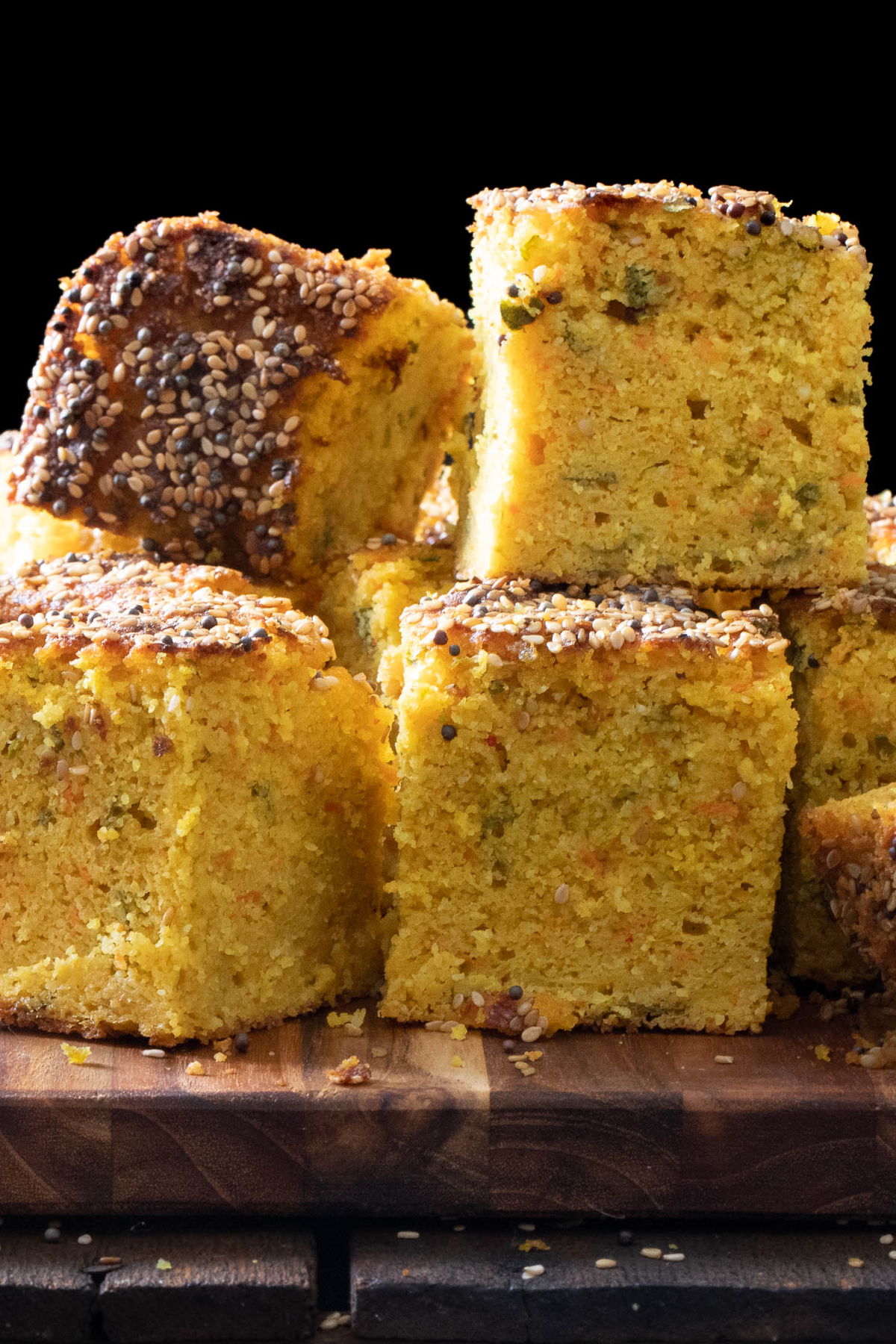
Ingredients
- 2 1/2 cups Handvo flour
- 1/2 cup yogurt
- 1 tsp salt (or to taste)
- 1 inch piece of ginger
- 1 Tbsp jaggery or brown sugar
- 1/2 tsp turmeric powder
- 2 green chilies
- 1 tsp Kashmiri chili powder
- 1 Tbsp lemon juice
- 2 Tbsp sesame seeds
- 2 tsp mustard seeds
- 2 tsp Eno (or baking soda + lemon juice)
- 1/4 cup methi leaves
- 2 1/2 cups shredded dudhi and carrots (or vegetables of choice)
- 3 Tbsp oil
- 2 cups water
Instructions
- Preheat the oven to 425°F.
- Grind together the ginger and chilies to make a paste. You can do this in a small blender, mortar, and pestle or by finely chopping them together.
- In a large bowl, mix the dry ingredients: handvo flour, salt, red chili powder, turmeric powder, and jaggery. Mix well to combine.
- Add yogurt and some water to form a batter with a cornbread consistency. It is best to add the water a little bit at a time, up to about 2 cups.
- Optional step: At this stage, you can ferment the batter for 12 to 24 hours by covering and placing it at room temperature.
- Add ginger and chili paste, fenugreek leaves, and grated vegetables. Mix well.
- If not fermented, add lemon juice and mix well. Set aside while you prepare the pan.
- Stir in the Eno into the batter. It should foam up.
- Prepare your pan. Brush a one quarter sheet pan or an 8x8 glass pan with oil. Sprinkle some (about a ¼) of the sesame and mustard seeds across the bottom of the pan.
- Add the batter to the pan. Top with remaining oil. Sprinkle with remaining sesame and mustard seeds.
- Bake for 45 minutes in the oven at 425°F until a knife stuck in the middle comes out clean.
- Optionally, end by broiling for 1-2 minutes to darken the top of the handvo, be careful not to burn it.
Notes:
Dudhi (opo squash) is the most traditional vegetable for handvo, but it is equally “traditional” to mix in whatever available vegetables: onions, potatoes, cabbage, carrots, pumpkin, just about anything will work.
Use a sheet pan instead of glass baking dish for the perfect crust.
